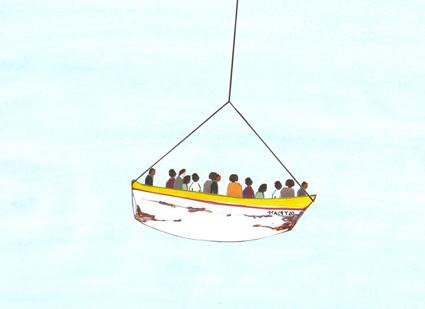State of Transit
dal 18/4/2012 al 20/5/2012
Segnalato da
barbaragurrieri
Taysir Batniji
Esra Ersen
Mario Rizzi
Zineb Sedira
Frida Carazzato
Maria Garzia
18/4/2012
State of Transit
Open Space - Zentrum fur Kunstprojekte, Wien
5 artists who have dedicated part of their research to the Mediterranean area and its dynamics of mobility. Works by /barbaragurrieri/group, Taysir Batniji, Esra Ersen, Mario Rizzi and Zineb Sedira.

Curated by Frida Carazzato and Maria Garzia
Artists: /barbaragurrieri/group, Taysir Batniji, Esra Ersen, Mario Rizzi and Zineb Sedira.
In the past the Mediterranean was a place of flourishing cultures that developed owing to the economic,
cultural and social relations between the peoples living on its shores. As recently stressed by various
curators’ and artists’ projects, the concept of the Mediteranean is much more than simply a geographical
term. The movements of capital as well as of people, the ideas that these entail, the stories of every
individual person and the inevitable effort and possibilities that these movements cause and trigger,
constitute elements that transform the Mediterranean to a space in which politics, business, literature and
desires mix.
Marked by colonial history and later processes of decolonialisation, the Mediterranean area is still having to
struggle with political and territorial conflicts and with the ongoing fall of dictatorial regimes, which now brings
to light the opposites that were previously hidden under a precarious balance. A region that presents itself as
a bridge between the peoples,1 while on the other hand also being a region of cross-overs between all the
populations that are driven to escape unequal economic developments.
In his essay Routes, the anthropologist James Clifford introduces the term of the “travelling cultures”. By this
he wants to say that modern cultures should no longer be interpreted as static and bound to a certain place,
but rather from a new perspective, linked to the notion of travelling. Thus as movement, mobility that is to be
seen as a departure from the home country and return to it, on the way to somewhere else so far unspecified
because of states of emergency or needs. The aspect of the journey in the sense attributed to it by Calvino,
as a journey of knowledge on the basis of the notion of ‘elsewhere’ – see a comparison of the dialogue
between Marco Polo and Kublai Khan in the Invisible Cities – becomes a metaphor for the search for an
individual identity and at the same time a collective identity concerning the subjects in movement, but also
for the search for identification as process of the reappropriation of the self. Transnationalism,
decentralisation, migration and hybridisation are phenomena that irretrievably change the culture of these
countries and their relationships to one another. Mobility seems to stress two further dynamics: the process
of destruction and the subsequent reconstruction of being and a permanent state of instability, a state of
transit that is expressed in the precarious living conditions.
State of Transit presents five artists who – based on the state of transit that has always characterised the
region in question – have dedicated part of their research to the Mediterranean area and its dynamics of
mobility. The works presented in the exhibition narrate personal stories reflecting also collective living
conditions that are linked with emigration because of various events or emergency situations. State of
Transit focuses on the artists’ effort to capture the “presence” of these stories of transit and constant new
beginning. These are extinguished or often forgotten stories like that of Ali Akilah in the film by Mario Rizzi or
those that remain anonymous precisely because they take place under the spotlight of the mass media, like
the animation by the /barbaragurrieri/group. These are stories from everyday life that appear almost banal
because of simple clichés, such as in the video by Esra Ersen or those reporting about places that are
normally left behind or where you decide to stay, such as in the shots by Zineb Sedira or places of transit
such as in the “stolen” pictures by Taysir Batniji. The movement of the individual within more complex
dynamics, often going beyond him or her into the area of geopolitics, the economy and major social
upheavals, is represented through the media of photography and of video, which have meanwhile become
protagonists of the live global transmission of the events. Although the works presented were produced
some years ago, they remain topical – less the isolated facts than those of the state of transit and the
presence of a time captured in the picture.
Opening 19 april, h.19
Open Space - Zentrum fur Kunstprojekte
Lassingleithnerplatz 2 - Wien
Friday, Saturday 13.00 – 18.30 and open for the rest of the week by appointment only
Admission free



